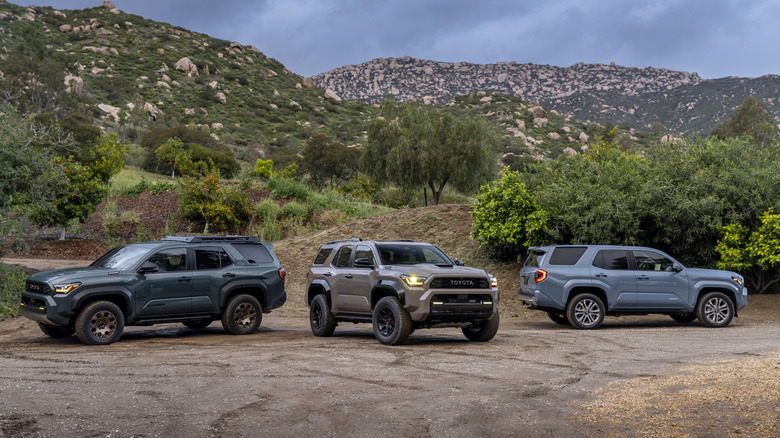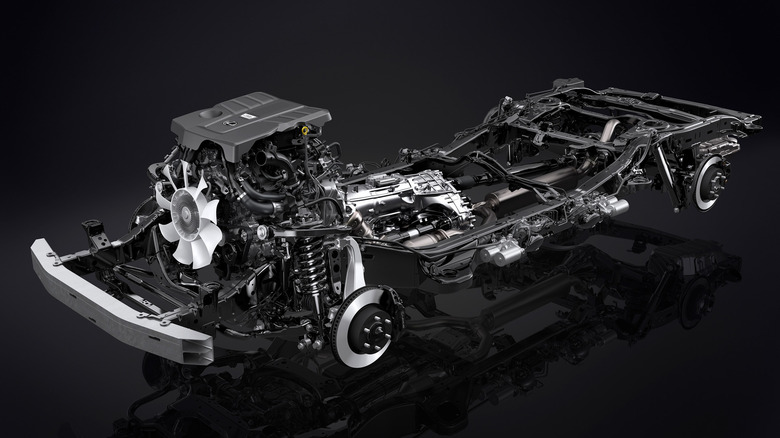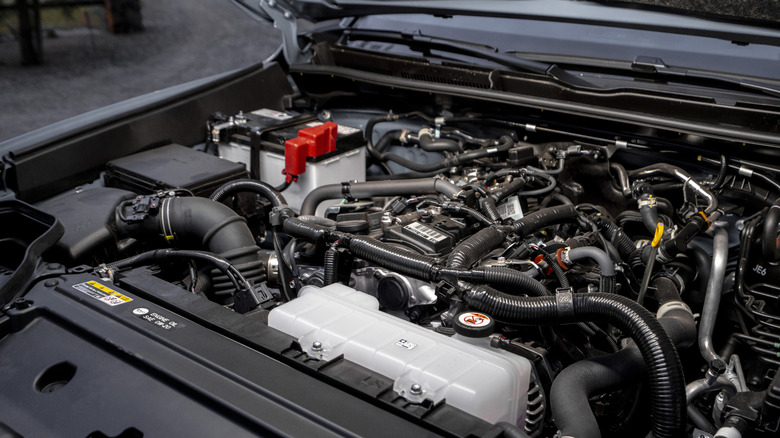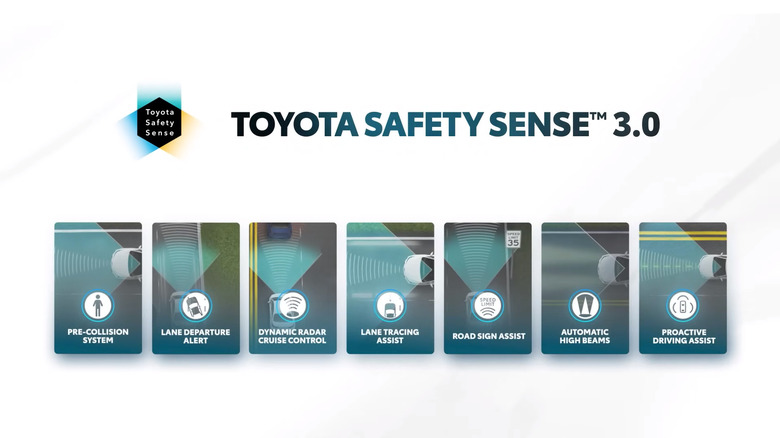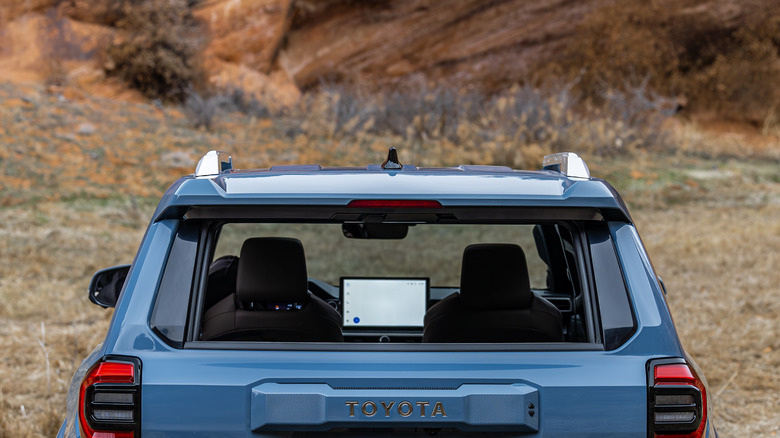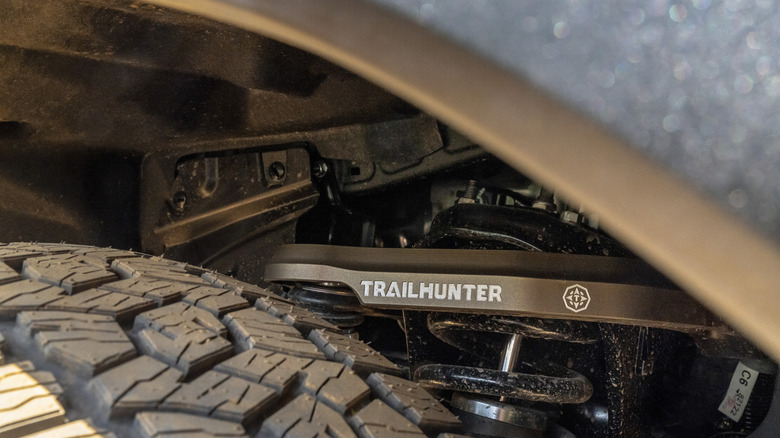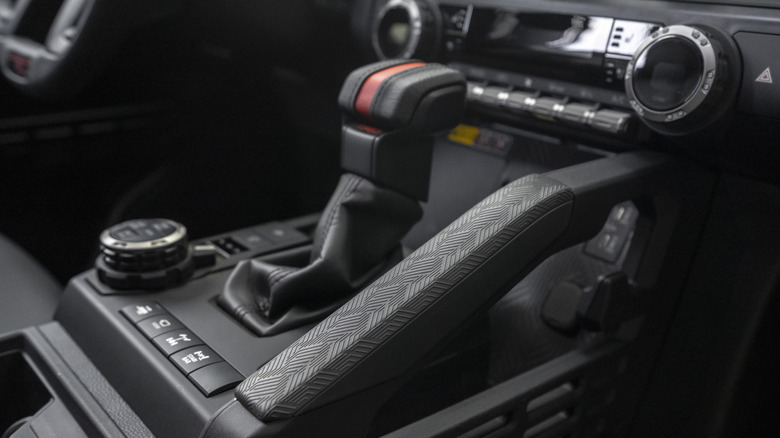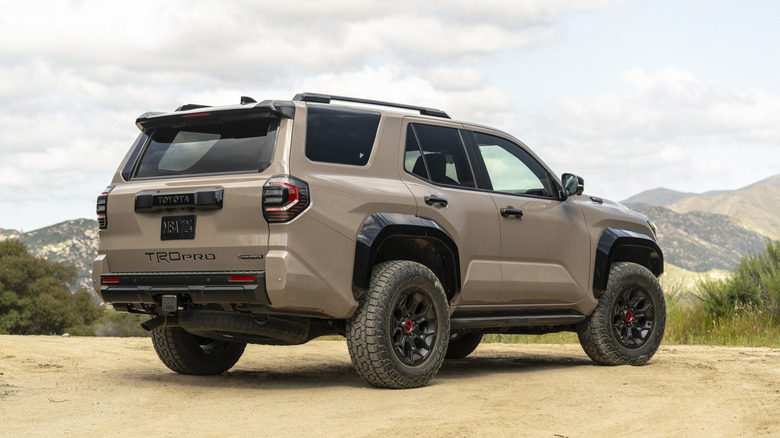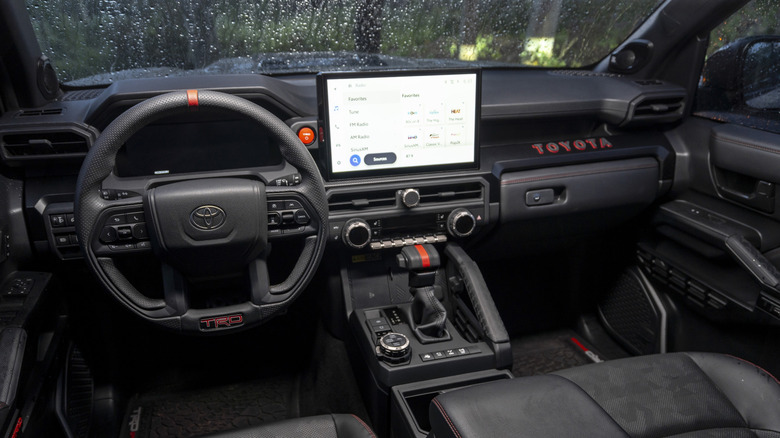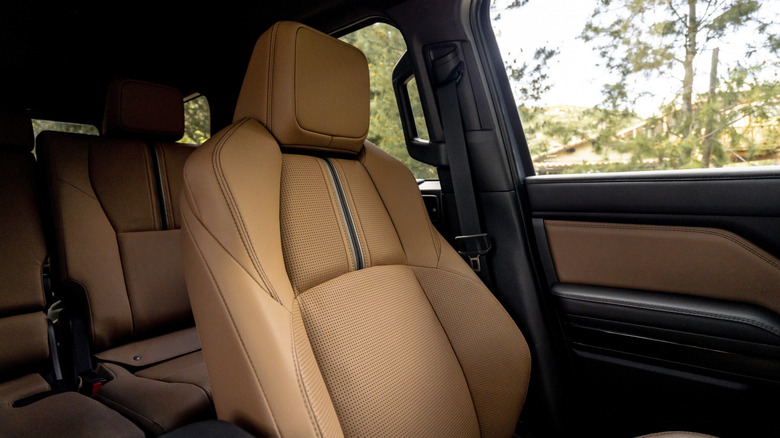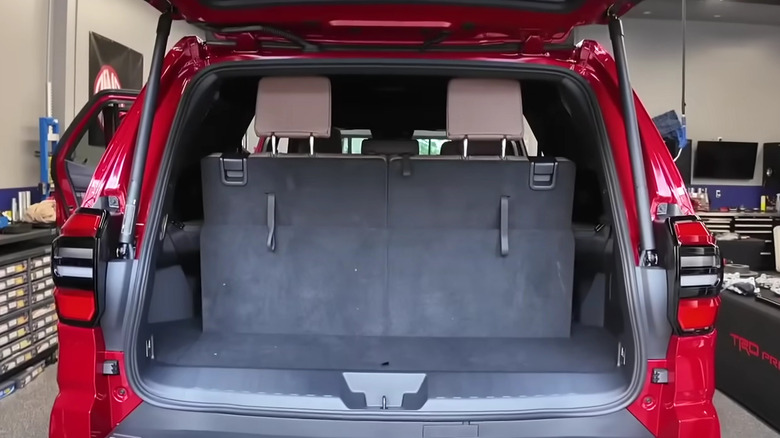10 Of The Coolest Features Of The Toyota 4Runner
The 4Runner appeared on the North American automotive scene in 1984 and immediately resonated with off-road enthusiasts. As Toyota's cheapest body-on-frame SUV, it was also the most approachable, which added to its popularity. Today, the 4Runner is in its sixth generation, packing new tech features to stay relevant, without losing its core qualities — ruggedness and off-road ability.
Still, throughout the generations, the 4Runner has gained some unique features that helped it stand out from its rivals. That's particularly true for the newest 2025 4Runner, which is perhaps the biggest upgrade the model has seen to date. Although it starts at a reasonable $40,770, Toyota's enthusiast SUV comes with many advancements inside and out. Heck, in some areas it even trumps the company's more expensive SUVs. In our 2025 Toyota 4Runner first drive feature we got up close and personal with the works.
For this piece, we've extracted only the coolest features of the Toyota 4Runner; some were already present in previous generations, while others are unique to the 2025 model. Either way, you'll get to learn the most interesting details about this capable SUV. Let's dig in!
The 2025 4Runner shares a platform with the Lexus GX and LX
Toyota's trucks and SUVs were built on different platforms in the past; the Land Cruiser was different from the 4Runner and Tacoma, for example. Today, every new Toyota model with a body-on-frame configuration shares the TNGA-F platform. This includes Lexus models like the latest GX 550 and LX 600. In fact, the 2025 4Runner, 2024 Land Cruiser, 2025 Lexus GX, and 2025 Lexus LX all have the same 112.2-inch wheelbase, suggesting a similar ladder chassis underneath.
So, yeah, 4Runner owners can now boast that their SUVs have the same underpinnings as a six-figure Lexus model. There are some small changes, like different thicknesses and materials of some parts, but the overall design is the same. For instance, Toyota used different materials in the 2025 4Runner to reduce weight, because this is the smallest SUV built on TNGA-F.
Still, there is more to the story here. To begin with, this allowed Toyota to have a fully featured portfolio of SUVs and trucks, aimed at a different demographic, while still making profits. Furthermore, the TNGA-F platform brings many benefits over its predecessor. Thanks to the use of high-strength steel and laser welds, the chassis is more rigid than before, while the aluminum upper body ensures lower weight. These upgrades improve the 2025 4Runner's handling, performance, off-road capability, and fuel economy.
New turbocharged and hybrid powertrains
When the 2025 Toyota 4Runner finally arrived, the SUV's devotees were in for a shock — the previous V6 engine had been replaced by a four-cylinder. Still, while the ancient 4.0-liter V6 was simple and relatively reliable, we found it lethargic and inefficient in our 2023 4Runner 40th Anniversary Edition review. It was also paired with an antique five-speed automatic, which made things even worse.
The new model's standard i-FORCE 2.4-liter turbocharged four-cylinder engine has Toyota's D-4ST system with direct and port injection to maximize performance and efficiency, and pairs exclusively with a new eight-speed automatic. It makes 278 hp, compared to 270 hp on the previous model, and has a much higher torque figure of 317 lb-ft (previously 278 lb-ft) available at just 1,700 rpm. The i-FORCE powertrain also trumps the predecessor on efficiency, getting up to 22 mpg combined, while the previous 4Runner was good for only 17 mpg combined!
The 2025 4Runner is also available with an electrified version of that same powertrain. Called the i-FORCE MAX, this hybrid configuration includes a 48-hp electric motor sandwiched between the engine and transmission. As a result, it makes 326 hp and completely bonkers 465 lb-ft of torque. With a fuel economy rating of 23 mpg combined, the hybrid is also slightly more economical, although it comes standard with 4WD. As a bonus, it comes standard with a 2,400W AC power supply. The i-FORCE MAX is optional on the Off-Road and Limited grades, and standard on the Trailhunter, Platinum, and TRD Pro.
Standard Toyota Safety Sense 3.0 on all new trims
In most vehicles, the cutting-edge active safety features sit behind a paywall. Fortunately, Toyota doesn't value the life of its customers based on their income, so the 2025 4Runner is equipped with all features from the Toyota Safety Sense 3.0 suite as standard. TSS 3.0 is also the company's most advanced safety suite that supports OTA (over-the-air) updates to improve the existing or add new functionalities.
As a part of TSS 3.0, you'll get a pre-collision System (PCS), which scans the road for vehicles, pedestrians, bicyclists, and motorcyclists and warns the driver either visually or audibly of imminent danger. The system also provides brake assist and works together with dynamic radar cruise control (DRCC) to allow a quasi-semi-autonomous drive. DRCC can keep a preset distance from the vehicle in front and works above 20 mph.
Lane departure alert and lane tracing assist also help the driver keep the vehicle between the white lines; the former issues audio and visual warnings, while the latter can steer the 4Runner to keep it in the lane when DRCC is activated. The 2025 4Runner is even equipped with proactive driving assist, which can anticipate obstacles, and then either reduce the speed or assist the driver by turning the steering wheel.
The TSS 3.0 system also adds some quality-of-life improvements with the automatic high beams (AHB), and road sign assist (RSA) features. Finally, the blind spot monitor (BSM) system can recognize vehicles even with a trailer attached, while the rear cross-traffic alert makes the driver aware of oncoming vehicles when backing out.
Standard power rear window
The roll-down rear window has always been one of 4Runner's most unique features. Still, due to added complexity and weight, Toyota considered scrapping it for the latest 2025 model. Fortunately, due to the power rear window being a fan-favorite 4Runner feature, it's continuing for another generation, with Toyota's engineers shaving weight from the components to keep it viable.
What makes the power rear window so special? Surfers love that they can put their boards through the opening. It's also good for grabbing smaller items from the trunk when parked in tighter areas, like groceries or backpacks. Moreover, dogs enjoy peeking out to get fresh air, and the whole cabin will also enjoy enhanced airflow. For instance, you can open all windows on the 4Runner, including the rear one, and there will be no buffeting. Lastly, you can use your 4Runner as a quasi-camper and roll down the rear window to get a better view of nature or more fresh air.
The Off-Road trims have great aftermarket equipment
The 4Runner comes in quite a few off-road trims, including the TRD Off-Road, TRD Pro, and Trailhunter. Each is aimed at a different type of all-terrain driving, though they all come with standard 4WD and electronically locking rear differential. As for other features, the TRD Off-Road comes equipped with 33-inch all-terrain tires on 18-inch alloy wheels and Bilstein monotube shocks with remote reservoirs. As such, it's a solid choice for most off-road driving scenarios, even more challenging ones.
The TRD Pro is best suited for fast Baja-style off-roading, thanks to its FOX 2.5-inch Internal Bypass QS3 shocks with piggyback-style remote reservoirs. These shocks react very quickly to changes in the surface, ensuring each wheel is connected to the ground even when driving more quickly. The trim features a standard stabilizer disconnect mechanism (SDM), which allows greater wheel travel for maximum traction on uneven surfaces while keeping the SUV stable and smooth on paved roads. The TRD Pro also comes with 33-inch Toyo Open Country A/T III all-terrain tires.
Then there is the 4Runner Trailhunter, which is specifically geared toward the overlanding crowd. On this model, you get special 2.5-inch shocks with piggyback-style remote reservoirs from Old Man Emu, designed to give you great wheel articulation and a smooth ride on very uneven surfaces. Still, the Trailhunter also comes with a unique roof rack from aftermarket specialist ARB, Rigid Industries color-selectable fog lights, and special high-strength steel skidplates. There is even a tall external air intake that draws clearer, dust-free air when off-roading, and the same 33-inch Toyo all-terrains as the TRD Pro.
Multi-terrain select ensures easy off-roading
Driving an off-road-ready SUV isn't as straightforward as many people think. Fortunately, Toyota made it easier for beginners with the multi-terrain select (MTS) feature, which was already available on the previous-gen 4Runner. All you need to do is select the gearing (high or low) and then choose between several modes, like Auto, Sand, Mud, Rock, Dirt, and Deep Snow. The system will then control wheel spin to get you out of trouble. However, enthusiast off-roaders can interfere and lock the rear differential if necessary.
As part of the MTS system, off-road 4Runner trims also come with Toyota's CRAWL Control feature. This functionality is like having cruise control for off-roading and works at very low speeds. It's particularly useful when driving over large rocks, allowing the driver to focus on steering alone, with the system taking care of driving over obstacles.
Another great feature in the 2025 4Runner, aimed at off-road enthusiasts, is the multi-terrain monitor. This system shows front, side, or rear underfloor camera views on the giant 14-inch infotainment screen. Thus, it allows the driver to spot obstacles, like large rocks, that are otherwise invisible from the cabin.
Great for towing
Although its four-cylinder engine might lead you to think it's a weakling, the 2025 4Runner is a towing beast. With its maximum towing capacity of 6,000 pounds, Toyota's latest off-roader can easily pull pop-up campers, smaller utility trailers, and small travel trailers. It's even good for some larger travel trailers and lightweight boat trailers.
But what does that mean relative to its competitors? The 2025 4Runner has a 1,000-pound higher towing capacity than its predecessor. Toyota's SUV also trumps most of its competitors. The Wrangler can only manage 5,000 pounds, and the Bronco only 4,500 pounds. The only off-roader that matches the 2025 4Runner is the 2025 Nissan Pathfinder, which can also tow an impressive 6,000 pounds. If you want a higher capacity, you'll need to go for a large SUV — here are the 10 best new SUVs for towing to help you out.
As for towing equipment, the 4Runner comes standard with an integrated towing receiver hitch and wiring harness with four-pin and seven-pin connectors. Off-road trims, like the TRD Pro, also get advanced towing tech, like an Integrated Trailer Brake Controller with Multi-Information Display, and Trailer Backup Guide with Straight Path Assist. Still, it's important to note that these models have a slightly lower 5,800-pound towing capacity, despite being equipped with the more potent i-FORCE MAX hybrid powertrain. Most likely, it's due to their higher curb weight.
Tech-laden interior
The 2025 4Runner enjoys a big tech jump inside the cabin, with a huge optional 14-inch infotainment touchscreen dominating the dashboard. Crucially, Toyota made significant software and hardware improvements to make it stand out. The HD display screen is now looks great, even in direct sunlight.
Furthermore, there's support for various apps, including an excellent navigation app and Apple Music. The operating system was developed by Toyota's Connected Technologies group in North America and is designed with user experience in mind. It also supports OTA (Over-The-Air) updates, meaning new features can be added down the line. Like any new in-car software, this one also has a Voice Assistant. The driver can engage it with "Hey Toyota," and ask it to change various settings. As an option, the 4Runner can also be equipped with a digital key, which allows you to use your smartphone to unlock the SUV. Wireless Apple CarPlay and Android Auto are also standard with the larger 14-inch screen
Although much more advanced, the system still features a big volume knob, as well as dedicated climate control knobs. Like the volume knob, they are chunky and easy to use even with gloves on. This is a breath of fresh air, given that most manufacturers put everything into the touchscreen these days.
The 14-inch screen on the 4Runner is always paired with a 12.3-inch digital gauge cluster, though lower trims get a regular instrument cluster and an 8-inch screen. A useful HUD (Heads-Up-Display) is also available on higher-end trims.
Luxurious Limited and Platinum trims
The 4Runner isn't just about ruggedness. The Limited and Platinum trims let you enjoy a more luxurious experience. The most notable addition to these trims is adaptive variable suspension (AVS), which lets the driver choose between a more comfortable ride or sharper handling.
Inside, both these trims come with the more advanced 14-inch infotainment and 12.3-inch digital gauge cluster. Furthermore, the 4Runner Limited has leather-trimmed seats with heating and ventilation for the front chairs, a heated steering wheel, and a Qi-compatible wireless charging pad. On the outside, the 4Runner Limited catches the eye with 20-inch gray alloys, satin chrome tri-bar grille, and satin chrome roof rails.
The Platinum trim is available for the first time in a 4Runner, bringing even more pizzaz compared to the Limited. Toyota says this model has premium leather seats with custom perforation and stitching, alongside standard HUD, digital rearview mirror, and rain-sensing automatic wipers. The 4Runner Platinum is also the only trim to get heated rear seats and comes with dark chrome tri-bar grille and roof rails on the exterior. It also has cool-looking 20-inch gloss black alloys to complement the dark details.
It's important to note that the Limited and Platinum trims lose the multi-terrain select system with crawl control and rear locking differential. When equipped with 4WD, they'll still be capable of tackling various terrains, but they could get stuck when things get more serious. The 4Runner Limited is available with both powertrains, but the Platinum is hybrid-only.
Optional third-row seats
The 4Runner is the smallest SUV built on the TNGA-F platform, measuring just over 16.2 feet long. It's shorter than the 2025 Land Cruiser, for example, which is just a little bit over 16.3 feet long. Still, unlike its more expensive sibling, the 4Runner comes with an optional third row. The two seats in the trunk are only available on models with the regular gas engine. It's probably due to the hybrid's battery, which seats under the trunk floor and takes up precious space. After all, the latest Land Cruiser is available with a non-hybrid engine and seven seats in other markets. In the U.S., it's hybrid-only.
But who's complaining? Having two more seats in an SUV can sometimes come in handy. Besides, its competitors lack the feature, which is a big plus for the 4Runner. The Wrangler is five-seat only. Same for the excellent Ford Bronco. Really, you should be spending much more to get three seating rows on SUVs from other brands. Also, 4Runner's rearmost seats fold down flat, so you are not losing trunk functionality.
